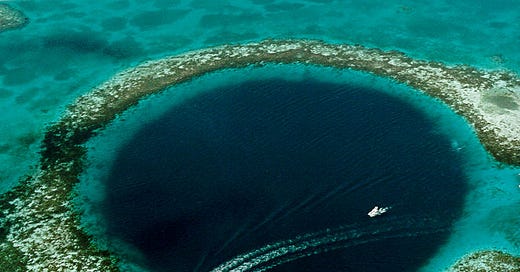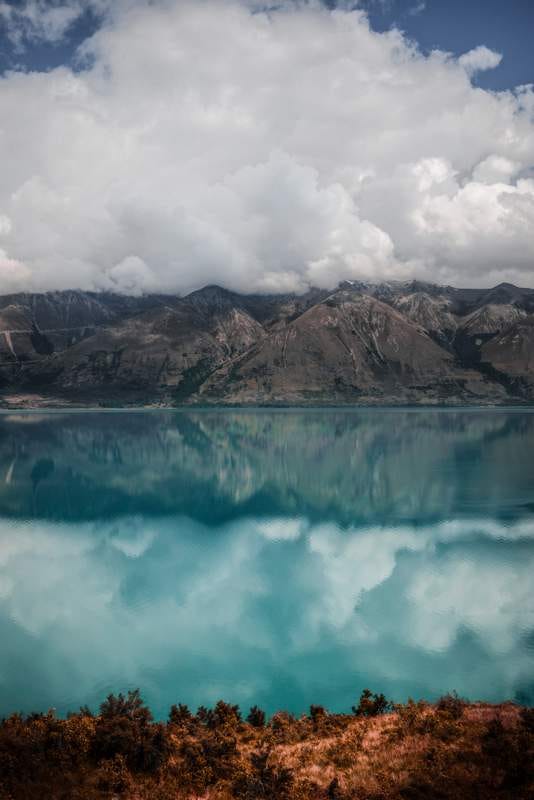Why It's Great News That The Earth Sucks
Okay, technically not "sucks", I mean "gravitational pull" - look, it's late and I needed a headline.
Hello! This is Everything Is Amazing, a newsletter about science, curiosity, impossible colours, hidden mountains, uh…fighting over scones, and also whatever this is.
One of the downfalls of running a newsletter like this is that you find people want to know more about you. You write like some kind of hypercaffeinated dimwit, so you must be hilarious in real life, they exclaim excitedly. Nothing I can say seems to deter these folk - so today, I’m trying a different tack.
This BBC report from 1973 was filmed in the seaside town that I grew up in - the town that, in essence, made me the man I am today. Please bear that in mind as you watch:
Any questions?
No?
Good stuff. Let’s keep it that way and get back to the science.
And regarding that - hey, a new ‘Blue Hole’ in the ocean floor has just been found!
No, not that one. That’s the arrestingly photogenic marine sinkhole in Belize, nicknamed The Great Blue Hole, which the French oceanographer Jacques Cousteau made famous with his investigations in 1971.
If you don’t feel a thrill of horror at the sight of it, allow me to give you a push: around 90 metres down, there’s a translucent layer of hydrogen sulfide that acts rather like a chemical guillotine, killing much of the marine life that strays into it. This means the night-dark floor of the hole at a depth of 124 metres (407 feet) is a graveyard, mainly for conch - and as the first of those unlucky victims decomposed, they stripped the oxygen out of the water, leaving it anoxic. Even if something survived the trip through that layer of liquid swamp gas, it’d quickly suffocate. A Pixar movie this ain’t.
And if you’re wondering how dangerous this could be for human life, three people have been reported missing around the Great Blue Hole - and in 2018, a team including Cousteau's grandson Fabien Cousteau and National Geographic explorer Erika Bergman found the bodies of two of them laying in the darkness, surrounded by conch shells, a 2-litre Coke bottle and a lost GoPro containing someone’s vacation photos.
So that’s the most famous Blue Hole - but it’s not the deepest. That honour goes to the Yongle Blue Hole (dramatically nicknamed the Dragon Hole) in the South China Sea, which plunges for 300 metres, roughly the same length as the Eiffel Tower. That one also highlights the danger of using the d-word: in July 2016, the Washington Post announced “Researchers just discovered the world's deepest underwater sinkhole in the South China Sea". Um - yes and no? They may have discovered it’s the deepest, but considering it’s believed to be mentioned in the 16th-Century Chinese novel Journey to the West (the inspiration for this delightfully insane TV show that I used to watch as a kid), that headline makes it easy to incorrectly give them credit for being the first to find it at all. Words, they be slippery, they be.
Similarly, the ‘newly-discovered’ Blue Hole in the Western Caribbean is called the Taam ja’ - and the researchers found it’s 274 metres deep, making it the second-deepest after Dragon Hole.
Aside from the sensationalist & morbidly creepifying side of it, why is this interesting? One reason: it’s a glimpse at an unusual environment that may mirror conditions on another world, in the same way the Lost City Hydrothermal Vent in the Atlantic might give clues to how life could survive in the as-yet-unconfirmed abyssal oceans of Jupiter’s moon Europa, as I wrote about here. But also, they’re just poorly understood features. The less that’s known, the more surprises could be waiting to be (truly!) discovered…
Right then. On with today’s fun thing!
Since September of last year, I’ve been investigating my way into the weighty topic of how the geology under our feet directly affects our lives, as part of the “season within a season” for paid subscribers to Everything Is Amazing.
We’ve looked at:
the impressive, worrying and occasionally ludicrous modern efforts to build artificial mountains (a now-unlocked post that everyone can read)
the way that deep geological time allowed everything to go everywhere (including how my nearest mountain here in Scotland travelled all the way up from near the South Pole)…
the enticing immensity of the Great Pangean Mountain Trail, running along both sides of the Atlantic and marking where ancient supercontinents were once wrenched apart…
the titanic ‘trees of fire’ and enormous blobs - yes, that’s the proper scientific term - that pump energy to the surface of our world…
the thousand invisible hands of a Scottish maelstrom (a now-unlocked post that everyone can read)…
…and the way plastics and discarded technology are turning into technofossils and new forms of rock.
But today, I’ll confess I’m an idiot, because I’m ending the series with the biggest effect of all, the one I probably should have started with, especially as reader Jenny indirectly tipped me off about it in the comments at the beginning of the season. (Thanks/sorry, Jenny!)
This one is about how perfectly we fit the world we live upon - and in the manner of many a classic science-adventure story, it starts with scientists on a mountainside, frowning at their instruments.





